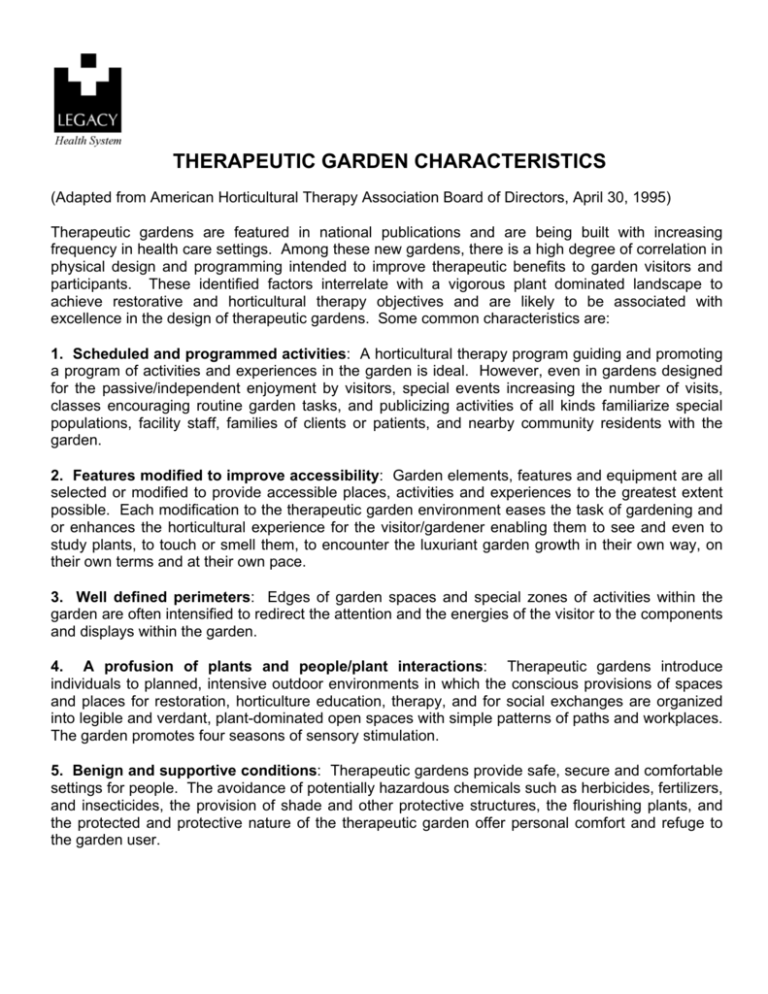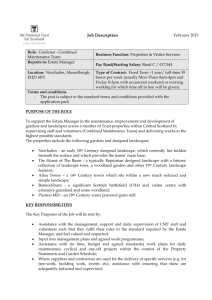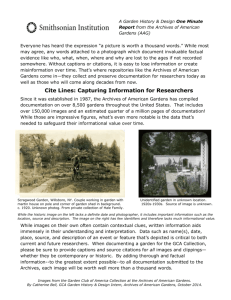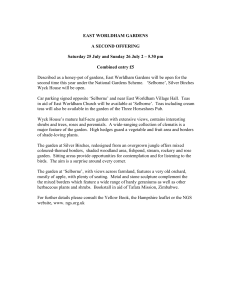therapeutic garden characteristics
advertisement

THERAPEUTIC GARDEN CHARACTERISTICS (Adapted from American Horticultural Therapy Association Board of Directors, April 30, 1995) Therapeutic gardens are featured in national publications and are being built with increasing frequency in health care settings. Among these new gardens, there is a high degree of correlation in physical design and programming intended to improve therapeutic benefits to garden visitors and participants. These identified factors interrelate with a vigorous plant dominated landscape to achieve restorative and horticultural therapy objectives and are likely to be associated with excellence in the design of therapeutic gardens. Some common characteristics are: 1. Scheduled and programmed activities: A horticultural therapy program guiding and promoting a program of activities and experiences in the garden is ideal. However, even in gardens designed for the passive/independent enjoyment by visitors, special events increasing the number of visits, classes encouraging routine garden tasks, and publicizing activities of all kinds familiarize special populations, facility staff, families of clients or patients, and nearby community residents with the garden. 2. Features modified to improve accessibility: Garden elements, features and equipment are all selected or modified to provide accessible places, activities and experiences to the greatest extent possible. Each modification to the therapeutic garden environment eases the task of gardening and or enhances the horticultural experience for the visitor/gardener enabling them to see and even to study plants, to touch or smell them, to encounter the luxuriant garden growth in their own way, on their own terms and at their own pace. 3. Well defined perimeters: Edges of garden spaces and special zones of activities within the garden are often intensified to redirect the attention and the energies of the visitor to the components and displays within the garden. 4. A profusion of plants and people/plant interactions: Therapeutic gardens introduce individuals to planned, intensive outdoor environments in which the conscious provisions of spaces and places for restoration, horticulture education, therapy, and for social exchanges are organized into legible and verdant, plant-dominated open spaces with simple patterns of paths and workplaces. The garden promotes four seasons of sensory stimulation. 5. Benign and supportive conditions: Therapeutic gardens provide safe, secure and comfortable settings for people. The avoidance of potentially hazardous chemicals such as herbicides, fertilizers, and insecticides, the provision of shade and other protective structures, the flourishing plants, and the protected and protective nature of the therapeutic garden offer personal comfort and refuge to the garden user. 6. Universal design: Therapeutic gardens are designed for the convenience and enjoyment for people with the widest possible range of conditions. As practical and pleasurable landscapes for people of all ages and all abilities, these gardens commonly stimulate the full range of senses including memory, hearing, touch, smell and sometimes taste as pleasurable alternatives to the visual experience of gardens. The therapeutic garden exploits the most complete range of people/plant interactions and experiences possible within its enclosures. 7. Recognizable placemaking: Therapeutic gardens are frequently simple, unified and easily comprehended places. An intensified recognition of garden patterns and garden experiences enhance the unique identity of a garden as a special place for the people it serves. Placemaking, an important strategy in all landscape design efforts, heightens the visitor’s focus on plant-related sensuality, comfort, and independence experienced within a therapeutic garden. Resources: Legacy Health and Portland Community College Therapeutic Horticulture Certificate coursework. Next series begins summer 2010. Inquire jabushak@pcc.edu or thazen@lhs.org http://www.pcc.edu/gerontology http://catalog.oregonstate.edu/OptionDetail.aspx?code=632&majorid=30 Legacy Gardens: Therapeutic Garden Design Workshop, October 19, 2009, 9:00 – 3:30 inquire thazen@lhs.org or www.legacyhealth.org and search “gardens”. American Horticultural Therapy Association Annual Conference www.ahta.org October 1-3, 2009 Pasadena, CA. American Society of Landscape Architects (ASLA) Therapeutic Gardens Professional Practice Network (PPN) http://host.asla.org/groups Chicago Botanic Garden, Healthcare Garden Design Certificate Program http://www.chicagobotanic.org Therapeutic Landscape Data Base http://www.healinglandscapes.org/contact.html http://tldb.blogspot.com/ 2009 Gardens in Senior Living Workshop http://www.centerofdesign.org/pages/memorygarden.htm Environment: Yale, Fall 2006, Nature in Humanities Habitat http://environment.yale.edu/pubs/Environment-Yale-Fall-2006 Teresia Hazen, MEd, HTR, QMHP Registered Horticultural Therapist Coordinator, Legacy Therapeutic Gardens & Horticultural Therapy Legacy Health System 1015 NW 22nd Ave. #529 Portland, Oregon 97210 503-413-6507 thazen@lhs.org 6/09








